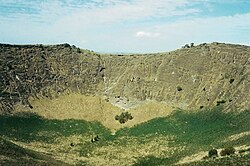East Australia hotspot


The East Australia hotspot is a volcanic province in southeast Australia which includes the Peak Range in central Queensland, the Main Range on the Queensland-New South Wales border, Tweed Volcano in New South Wales, and the Newer Volcanics Province (NVP) in South Australia. A number of the volcanoes in the province have erupted since Aboriginal settlement (46,000 BP). The most recent eruptions were about 5,600 years ago, and memories of them survive in Aboriginal folklore. These eruptions formed the volcanoes Mount Schank and Mount Gambier in the NVP. There have been no eruptions on the Australian mainland since European settlement.
Unlike most hotspots, the East Australia hotspot has explosive eruptions as well as the runny lava flows of the Hawaii hotspot, the Iceland hotspot and the Réunion hotspot. The hotspot is thought to be explosive because basaltic magma interacts with groundwater in aquifers below the surface producing violent phreatomagmatic eruptions.[1]
The cause of volcanism in the area is uncertain. Theories typically fall into one of two categories: the mantle plume theory and the plate theory. On the basis of the long duration of volcanic activity, its vast lateral extent, geochemistry of lavas, and Seismic, it has been proposed that the region is underlain by one or more deep mantle plumes which have forced magma up through points of weakness in the Indo-Australian Plate as it has moved northward over the source.[2][3][4][5]
Several observations, however, such as the lack of clear age progression across much of the province and the orientation of the NVP which is orthogonal to plate motion, are inconsistent with plume models.[1] Seismic anomalies, moreover, terminate at a depth of around 200 km, making the presence of a mantle plume unlikely.[6]
In opposition to plume models, various tectonic causes have been proposed. Some studies have argued that volcanic activity results from a combination of edge-driven convection (small-scale, shallow mantle convection caused by a change in lithospheric thickness at the continental margin where thick continental lithosphere meets thinner oceanic lithosphere) and decompression of the crust from normal faulting caused by plate stresses.[1][6] Another view is that extension from stresses brought about by changes in plate boundary configurations has caused severe lithospheric thinning resulting in decompression melting of the asthenosphere.[7] Both of these models invoke shallow processes closely related to the operation of plate tectonics and so fall under the plate theory.[8][9] Other models combine both plume and plate-tectonic processes.[10][11][12]
See also
References
- ^ a b c Cas, R.A.F.; van Otterloo, J.; Blaikie, T.N.; van den Hove, J. (2017). "The dynamics of a very large intra-plate continental basaltic volcanic province, the Newer Volcanics Province, SE Australia, and implications for other provinces". In Németh, K.; Carrasco-Núñez, G.; Aranda-Gómez, J.J.; Smith, I.E.M. (eds.). Monogenetic volcanism. Geological Society, London, Special Publications, 446. Geological Society of London. pp. 123–172. doi:10.1144/SP446.8.
- ^ Sutherland, F.L. (1991). "Cainozoic volcanism, Eastern Australian: a predictive model on migration over multiple 'hotspot' magma sources". In DeDeckker, P.; Kershaw, A.P. (eds.). The Cainozoic in Australia: A re-appraisal of the evidence. Geological Society of Australia, Special Publications, 18. Geological Society of Australia. pp. 15–43. ISBN 0-909869-76-6.
- ^ Graeber, F.M.; Houseman, G.A.; Greenhalgh, S.A. (2002). "Regional teleseismic tomography of the western Lachlan Orogen and the Newer Volcanic Province, southeast Australia". Geophysical Journal International. 149 (2): 249–266. doi:10.1046/j.1365-246X.2002.01598.x.
- ^ Montelli, R.; Nolet, G.; Dahlen, F.A.; Masters, G. (2006). "A catalogue of deep mantle plumes: New results from finite‐frequency tomography". Geochemistry, Geophysics, Geosystems. 7 (11). doi:10.1029/2006GC001248.
- ^ Jones, I.; Verdel, C. (2015). "Basalt distribution and volume estimates of Cenozoic volcanism in the Bowen Basin region of eastern Australia: Implications for a waning mantle plume". Australian Journal of Earth Sciences. 62 (2): 255–263. doi:10.1080/08120099.2015.997796.
- ^ a b Davies, D.R.; Rawlinson, N. (2014). "On the origin of recent intraplate volcanism in Australia". Geology. 42 (12): 1031–1034. doi:10.1130/G36093.1.
- ^ Aivazpourporgou, S.; Thiel, S.; Hayman, P.C.; Moresi, L.N.; Heinson, G. (2015). "Decompression melting driving intraplate volcanism in Australia: Evidence from magnetotelluric sounding". Geophysical Research Letters. 42 (2): 346–354. doi:10.1002/2014GL060088.
- ^ Foulger, G.R.; Natland, J.H. (2003). "Is "hotspot" volcanism a consequence of plate tectonics?". Science. 300 (5621): 921–922. doi:10.1126/science.1083376.
- ^ Foulger, G.R. (2007). "The 'plate' model for the genesis of melting anomalies". In Foulger, G.R.; Jurdy, D.M. (eds.). Plates, plumes, and planetary processes: Geological Society of America Special Paper 430. The Geological Society of America. pp. 1–28. ISBN 978-0813724300.
- ^ Holt, S.J.; Holford, S.P.; Foden, J. (2014). "New insights into the magmatic plumbing system of the South Australian Quaternary Basalt province from 3D seismic and geochemical data". Australian Journal of Earth Sciences. 60 (8): 797–817. doi:10.1080/08120099.2013.865143.
- ^ Davies, D.; Rawlinson, N.; Iaffaldano, G.; Campbell, I.H. (2015). "Lithospheric controls on magma composition along Earth's longest continental hotspot track". Nature. 525: 511–514. doi:10.1038/nature14903.
- ^ Rawlinson, N.; Davies, D.R.; Pilia, S. (2017). "The mechanisms underpinning Cenozoic intraplate volcanism in eastern Australia: Insights from seismic tomography and geodynamic modeling". Geophysical Research Letters. 44 (19): 9681–9690. doi:10.1002/2017GL074911.
External links
